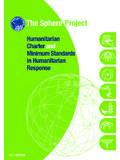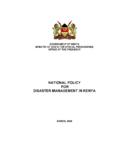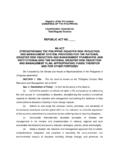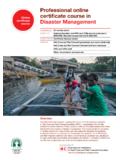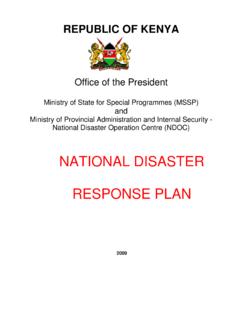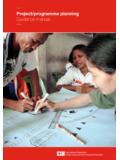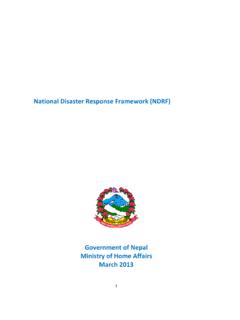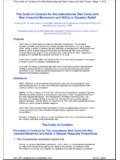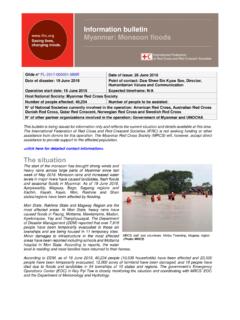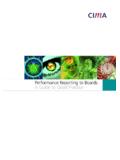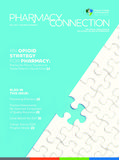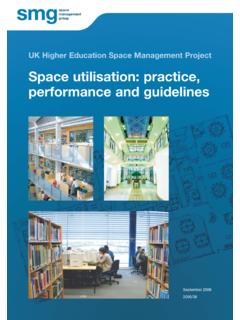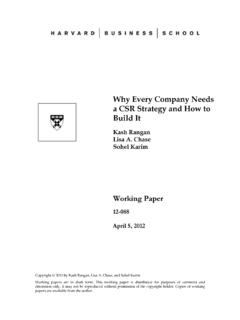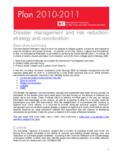Transcription of IFRC STRATEGY ON VIOLENCE PREVENTION, MITIGATION …
1 IFRC STRATEGY ON VIOLENCE prevention , MITIGATION AND response 2011-2020 Strategic directions to address interpersonal and self-directed VIOLENCE IN SuPPORT OFPhoto: Brian Powell/IStockIFRC STRATEGY ON VIOLENCE prevention , MITIGATION AND response 2011-20202 Among the continuing and tragic vulnerabilities to humans around the world is VIOLENCE . VIOLENCE is pervasive, often hidden and secretive; when people hurt themselves or others the humanitarian consequences are catastrophic. Regardless of what form VIOLENCE takes, who it targets, where it occurs, or how it is justified, its toll is undeniably disastrous. The 2007 Declaration Together for Humanity , adopted at the 30th International Conference of the Red Cross and Red Crescent recognized VIOLENCE as one of the world s greatest humanitarian challenges.
2 Conference participants all National Red Cross and Red Crescent Societies, States parties to the Geneva Conventions on International Humanitarian Law, the International Federation of Red Cross and Red Crescent Societies (hereafter IFRC ) and the International Committee of the Red Cross (hereafter ICRC ) - expressed their commitment to intensify efforts to prevent, defuse or mitigate VIOLENCE , particularly in urban settings. Based on these commitments, the IFRC Secretary General made the development of an IFRC Global STRATEGY on VIOLENCE (hereafter the STRATEGY ), a 2008-2009 secretariat objective, as approved by the Governing Board in May December 2008, the secretariat s principles and values department, together with the Canadian Red Cross, organized a three-day high-level meeting on VIOLENCE , gathering 22 National Societies1 active in VIOLENCE prevention , MITIGATION or response from all over the world (hereafter the high-level meeting ).
3 In addition there was also participation from the ICRC, FOREWORD1 Argentine Red Cross, Cameroon Red Cross, Canadian Red Cross, Colombian Red Cross, Guyana Red Cross, Honduran Red Cross, Indian Red Cross, Irish Red Cross, Italian Red Cross, Jamaican Red Cross, Kenya Red Cross, Liberian Red Cross, Mongolian Red Cross, Norwegian Red Cross, Red Cross of the Democratic Republic of Congo, Salvadorean Red Cross, Samoa Red Cross, Red Cross of Serbia, Sierra Leone Red Cross, South African Red Cross, Spanish Red Cross, and Sri Lanka Red Cross2 The network on VIOLENCE is currently formed by National Societies which participated in the high-level meeting on VIOLENCE (see footer 1 on this page) plus the Australian Red Cross and the Cambodian Red CrossOur special gratitude goes to Sandra Gutierrez (Senior Officer VIOLENCE prevention as Staff on loan from Spanish Red Cross), Gurvinder Singh (Advisor, VIOLENCE prevention , International Operations, Canadian Red Cross); Judi Fairholm (National Director, RespectED: VIOLENCE and Abuse prevention , Canadian Red Cross) and Dr.
4 Katrien Beeckman (Head, P&V department) for their leadership and commitment in driving the STRATEGY development , UNICEF, UNHCHR, the Paolo Freire Institute and Boston University School of Public high-level meeting determined a framework from which to build a global STRATEGY , a definition of VIOLENCE , the IFRC vision and mission regarding VIOLENCE , as well as guiding standards for the secretariat and National Societies in their work to address STRATEGY is the result of a collaborative process involving a Network of National Societies2 under the leadership of the principles and values department, the Canadian Red Cross and the Spanish Red Cross. The network has co-shaped and developed the STRATEGY through the following steps:(i) survey and questionnaire on National Society VIOLENCE prevention , MITIGATION and response activities and approaches (ii) thematic papers on a cross-section of types of VIOLENCE (see appendix 1)(iii) comparative analysis of current National Society practice in VIOLENCE prevention , MITIGATION , response (iv) feedback on previous drafts of the STRATEGY .
5 Bekele Geleta Secretary GeneralIFRC STRATEGY ON VIOLENCE prevention , MITIGATION AND response 2011-20203 VIOLENCE touches everyone it is a global humanitarian catastrophe that affects all continents, countries and communities. The most prevalent types of VIOLENCE are self-directed and interpersonal, which constitute the scope of this STRATEGY . The STRATEGY excludes collec-tive VIOLENCE such as armed conflicts and internal strife; VIOLENCE within this STRATEGY pertains to self-directed and interpersonal VIOLENCE . Although VIOLENCE is often kept hidden and secret, it can occur at any time, in any place, and is manifested as physical, emotional/psychological, sexual VIOLENCE or neglect.
6 Regardless of age, gender, background, or sta-tus, VIOLENCE degrades, diminishes and denies human dignity, respect, health, and life; its toll on economies and community-development is VIOLENCE is pervasive and complex, it is not inevitable. VIOLENCE can be prevented, mitigated and responded to. For this to occur, the underlying root causes of VIOLENCE must be addressed through compre-hensive, evidence-based, persistent and coordinated The humanitarian catastrophe of VIOLENCE has been rec-ognized in Red Cross Red Crescent statutory decisions for decades and has gained more prominence in recent years. Two significant milestones mark the increased emphasis placed on VIOLENCE : in 1999, the 28th Interna-EXECUTIVE SUMMARY tional Conference of the Red Cross Red Crescent pre-sented an official plan of action on non-discrimination and non- VIOLENCE followed by the 2007 30th Interna-tional Conference where VIOLENCE was declared one of the greatest humanitarian challenges facing the world.
7 Within the IFRC, there is considerable experience illus-trating clear and significant roles in preventing, mitigat-ing and responding to interpersonal and self-directed VIOLENCE . Through the International Red Cross and Red Crescent Movement s Fundamental Principles and humanitarian values, the commitment and dedication of millions of volunteers, community-based approaches, and the capacity to forge key partnerships, the IFRC is positioned to make a powerful contribution to end this humanitarian crisis. By mobilizing the power of human-ity to address the root causes of interpersonal and self-directed VIOLENCE , reduce its burden, and advance the safety and dignity of vulnerable people the IFRC can nurture a culture of non- VIOLENCE at local and global levels.
8 This STRATEGY has been prepared by the IFRC to pro-vide specific strategic directions to National Societies and their federation to support the strategic aims and enabling actions of the IFRC STRATEGY 2020, as each one of them relates to VIOLENCE prevention , MITIGATION and response . The current document observes the following structure: Part 1 is an introduction that provides the purpose and scope of the STRATEGY ; defines key concepts and explains the basis of the STRATEGY Part 2 provides an overview of why VIOLENCE is a great humanitarian challenge through a description of its impact, categories of vulnerable people, root causes and the inter-relatedness of VIOLENCE with other humanitarian challenges Part 3 defines where we stand now as the IFRC in terms of our statutory and operational framework and activities in the area of VIOLENCE prevention , MITIGATION and response Part 4 describes where we are going through an overview of specific, measurable actions targeting each of the strategic aims and enabling actions of STRATEGY 2020.
9 IFRC STRATEGY ON VIOLENCE prevention , MITIGATION AND response 2011-20204 TABLE OF CONTENTS1. IntroductIon: the IFrc STRATEGY on VIOLENCE prevention , mItIG atIon and reSponSe3. Where doeS the IFrc Stand on VIOLENCE prevention , mItIG atIon and response ? 2. VIOLENCE : Why IS It a Great humanItarIan challenGe?4. StrateGI c dIrectIonS For InterperSonal and SelF-d Irected VI olence prevention , mItIG atIon and response that Support the StrateGI c aImS and enaBlInG actIonS oF IFrc STRATEGY Purpose and scope of the STRATEGY .. Terms and definitions: categories, types and forms of VIOLENCE .. Basis of the STRATEGY ..p . The IFRC statutory framework on VIOLENCE .
10 The IFRC operational framework on VIOLENCE .. Key lessons learned and guiding standards on work on VIOLENCE within the IFRC .. Key lessons learned .. Role and guiding standards for action on VIOLENCE .. The disastrous impact of VIOLENCE .. People at particular risk to VIOLENCE .. Root causes or social determinants of interpersonal and self-directed VIOLENCE .. Inter-relatedness of today s great humanitarian challenges .. STRATEGY ON VIOLENCE prevention , MITIGATION AND response purpoSe and Scope oF the StrateGyThe purpose of the IFRC STRATEGY on VIOLENCE prevention , MITIGATION and response is to provide specific strategic directions to National Societies and their Federation to implement the strategic aims and enabling actions of IFRC STRATEGY 2020 as each of them relates to VIOLENCE in the forms of self-directed and interpersonal VIOLENCE including urban VIOLENCE .
